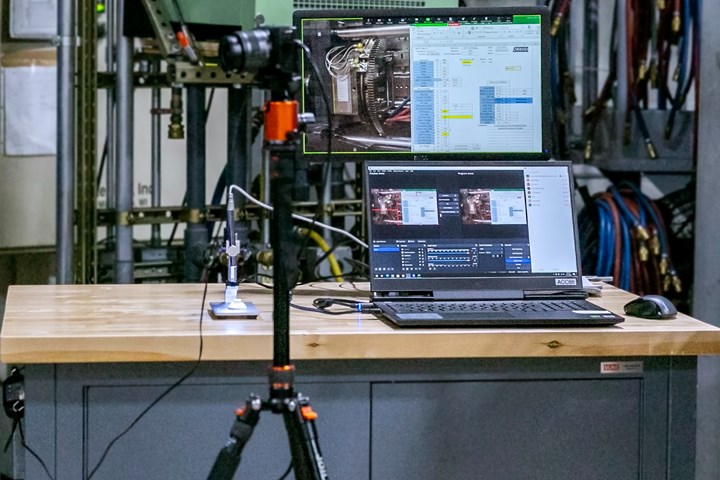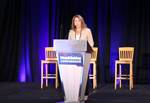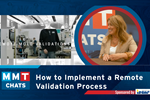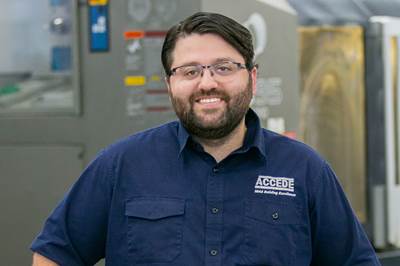
The Accede Mold and Tool team is committed to making every mold validation as seamless and detailed as possible for which virtual samples have become a very effective and efficient option. Photo Credit, all images: Angie Steingass.
Here is how a Rochester, New York-based, family-owned mold builder, Accede Mold & Tool, innovated to overcome obstacles presented by travel restrictions and customer budget constraints by developing and implementing a remote mold validation process. While born out of necessity during the emergence of the pandemic, the process persists and has delivered considerable time and cost savings for its customers and benefits for the mold builder.
“Our journey was fueled by innovation and inspired by the resilience of our industry,” says Camille Sackett, Accede’s VP of sales and marketing. “It’s a story of how challenges spark creativity and how even in the face of a global crisis, we found a way not only to adapt but to thrive.”
“Accede Mold & Tool needed a solution to bridge the gap between its expertise and its customers’ needs regardless of where they were on the globe. And so the concept of a remote mold validation process was born.”
To set the stage, let’s rewind to COVID-19 when lockdowns and travel restrictions swept across the globe, disrupting industries, businesses and our daily lives. In the heart of this storm, the moldmaking industry was faced with a dilemma that it couldn’t ignore: How do we continue to validate molds and serve customers effectively when travel restrictions and physical limitations exist?
Amid this challenge, the Accede team knew it had to think differently. “We needed a solution to bridge the gap between our expertise and our customers’ needs, regardless of where they were on the globe. And so the concept of a remote mold validation process was born,” Sackett says.
This concept would redefine the way Accede worked, collaborated and innovated. The company immediately equipped the sampling lab with cameras, microscopes and digital connections, transforming them into windows through which customers could peer into Accede’s mold validation process from thousands of miles away.
“But this wasn’t just about technology; it was about human connection. It was about finding a way to engage our customers, to let them be a part of the process and to ensure their molds were meticulously validated, no matter where they were in the world,” Sackett notes.
And here’s where the magic happened. The remote mold validation process wasn’t just a workaround; it was a revelation. It streamlines processes, saving customers time, costs and the complexities of travel.

A standard virtual mold sampling includes pre-planning with the customer to set expectations and determine the appropriate camera angles.
Remote Validation in Action
Today’s customers are spread too thin to spend days on-site qualifying the mold, which could be performed virtually. “Our job is to make that experience seamless, detailed and effective,” Accede President Roger Fox says. “Virtual samples are the most effective and efficient way to keep the focus on the mold and ensure performance excellence.”
“A remote validation, also referred to as a virtual sample, is a scheduled video-streamed presentation of a customer’s mold throughout a sample run, after Accede’s internal First Out of Tool (FOT). A standard virtual sample includes pre-planning with the customer to determine expectations, necessary camera angles and time frame of the sample,” Accede VP of engineering Brett Lindenmuth explains.
For remote mold validation, Accede has a carefully curated kit that contains a decently powered computer for graphics, cam links to turn regular high-performance cameras into webcams, a USB microscope for inspecting plastic parts under magnification, studio lights, mounts and noise-canceling headsets for the production environment. This kit ensures Accede is always prepared for remote mold validations.
“Our journey in video production of the remote mold validation began with FaceTime, which had its limitations in terms of quality and interaction,” Sackett says. “We then explored Vimeo livestream software, which was more one-way communication and not suitable for the collaborative nature of mold validations. Eventually, we settled on OBS Studio software, an open source platform that allowed us to customize the feed connecting to the Zoom meeting.”

A remote validation kit includes computer for graphics, cam links, a USB microscope, studio lights, mounts and noise-canceling headsets.
Step-by-Step
Once the FOT, mechanical qualification and process development are completed, and the Accede team decides that the tool runs as intended and the molded parts meet specifications, a virtual sample meeting is scheduled with the customer. The Accede team verifies the customer’s availability for the virtual mold sampling meeting, including date, time, audience, goals, etc., to ensure cameras are appropriately staged, and the team is set up to meet the customer’s expectations.
After determining the meeting date and time, Accede issues an Outlook meeting invitation with the link to the virtual meeting (Zoom meeting) to the customer team and the Accede team. Additionally, a copy of the molding process parameters is distributed to the participants 24 hours before the virtual meeting starts.
Before the scheduled meeting, the mold sampling manager and the program engineer set up the equipment (computers, cameras, lights, microphones, etc.) in the area where the mold trial will take place. The Accede team ensures that all broadcasting equipment is working properly and is ready for the virtual mold trial. The sampling team also ensures that the molding machine and mold are running as expected.
Approximately 30 minutes before the meeting starts, the Accede team decides which team member will be the “lead” and the “video engineer” for the meeting. The lead member manages and directs the meeting content and actions, while the video engineer handles raw video signals and broadcasts the video content during the virtual meeting session. The rest of the Accede team are “supporting members” and become actively involved in the virtual meeting as needed.
“Our remote mold validation process not only saved costs and time but fostered better collaboration and participation, enhancing the overall customer experience and operational efficiency.”
About 10 minutes before the meeting, the Accede team launches the Zoom meeting, allowing participants to log in. At this point, Accede employees test their microphone equipment to ensure it is functioning properly. Once this verification is complete, each Accede employee mutes their microphone to minimize background noise.
At the scheduled time, the Zoom meeting goes live and broadcasts the video content. The Accede lead member kicks off the meeting with an introduction of the meeting attendees and a quick overview of Accede’s virtual meeting capabilities (camera views, molding machine clamp view, molding machine screen view, high-resolution camera displaying molded parts, etc.). All virtual sample meetings are recorded and a copy of the video is stored in the project’s electronic sampling folder.
The initial focus of the virtual meeting is the demonstration of the mold sequence and related mold functions while the machine is on cycle. The Accede team may manually cycle the clamp, ejectors, stripper plates, etc., to demonstrate that the mold operates as expected. During this process, the customer may have specific requests, which Accede makes every effort to meet.
Once the customer is comfortable with the operation (functions) of the mold, the focus shifts to the injection molding process and molded part configurations. The Accede lead and video engineer encourage and solicit customer feedback to ensure Accede meets the customer’s virtual mold trial expectations. The intent is to make the customer feel like they are right next to the press.
When the Accede team has displayed all the expected video “scenes” for the customer, the lead will tactfully share some reflective statements to start bringing the meeting to closure. If the customer still has additional requests, the Accede team honors these requests, as appropriate. Then, the lead wraps up the meeting and thanks the customer for their participation. If there are no objections, the lead ends the meeting and the video engineer stops broadcasting the video signal.
The Accede team properly stores the equipment and organizes the area. Any meeting action items are documented and action items are shared with the proper stakeholders.

Joel Ellinwood, Accede Mold and Tool mold sampling manager, participates in on-site, remote and hybrid customer mold validations.
The Process Persists
Long after COVID, Accede’s remote validation continues, including a hybrid model with one or two customers on-site for the mold sample while their customer’s team — or their customer’s customer — participates using the remote model. For example, a customer based in California required on-site mold validation, which traditionally meant their physical presence at Accede’s facility. However, budget limitations, geographical distance and the need for efficient collaboration posed challenges. The solution was a remote mold validation process that leveraged technology and virtual collaboration tools to bridge the gap. This involved camera integration for real-time visual data, Zoom meetings for virtual connections and flexible participation for multiple stakeholders. The remote mold process enabled more individuals from the customer side to actively participate, resulting in a successful mold validation without the need for a physical presence.
Sackett notes that the remote mold validation process not only saved costs and time but fostered better collaboration and participation, enhancing the overall customer experience and operational efficiency.
“Even in the most trying times, we can find new ways to excel, connect and serve our customers,” Sackett points out. “Our journey through the pandemic wasn’t just about surviving; it was about thriving, evolving and emerging stronger than ever. We’ve redefined the mold validation process, showing that challenges can give birth to innovation that not only solves immediate problems but reshapes the way we approach our work.”
To learn more, visit the ACCEDE team at NPE2024
in the West Concourse Booth 381.
Related Content
What You Need to Know About Hot Runner Systems and How to Optimize Their Performance
How to make the most out of the hot runner design, function and performance.
Read MoreHow to Use Scientific Maintenance for More Accurate Mold and Part Troubleshooting
Discover how adopting scientific maintenance approaches helps improve mold lifespan, minimize failures, and optimize production outcomes.
Read MoreWhat Is Scientific Maintenance? Part 1
Part one of this three-part series explains how to create a scientific maintenance plan based on a toolroom’s current data collection and usage.
Read MoreQuestions and Considerations Before Sending Your Mold Out for Service
Communication is essential for proper polishing, hot runner manifold cleaning, mold repair, laser engraving and laser welding services.
Read MoreRead Next
Editorial Advisory Board 2023-2026: Corey Alton Fox, Accede Mold & Tool
The 2023-2026 version of MoldMaking Technology’s EAB features a new crew of industry professionals. Meet Corey.
Read MoreEditorial Advisory Board 2023-2026: Camille Sackett, Vice President of Sales and Marketing for Accede Mold & Tool
The 2023-2026 version of MoldMaking Technology's EAB features a new crew of industry professionals. Meet Camille Sackett
Read MoreMMT Chats: How to Implement a Remote Validation Process
Accede Mold & Tool Co. turned a workaround process for the pandemic into a permanent mold validation process.
Read More






















